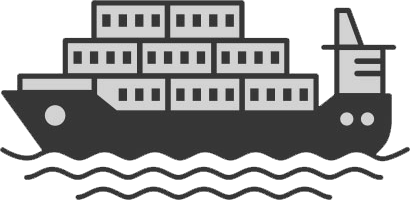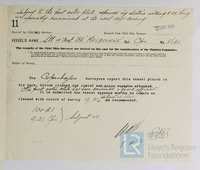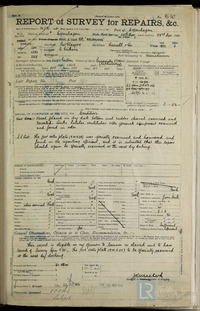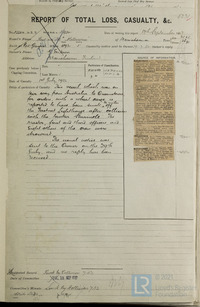- Related documents Related
- Complete documents list Documents
- Report ship? Report?
Use the data export button to extract customised data sets from the Ship Plan and Survey Report Collection. Available in TSV and CSV formats.
Name of ship as recorded on the record
The process of transferring a vessel to water, but not necessarily her completion.
Unique identifier for a given ship, it is assigned by a builder.
The port or place in which the vessel’s construction took place, at the time of writing.
Broad categories and subdivisions of vessels related to their purpose or function.
A vessel’s means of propulsion.
Confirmation as to whether the vessel was equipped with refrigeration machinery to aid in the transport of frozen or chilled cargo/goods.
Refrigeration machinery fitted for cargo purposes?
No ( Remarks of the chief ship surveyor to the Classing Committee regarding Melbourne, 8 October 1931 1931, Report of survey for repairs for Melbourne, 30 September 1931 1931, Report of total loss and casualty for Melbourne, 13 September 1932 1932 )
Does the vessel possess an auxiliary power source?
Is electric lighting fitted to the vessel?
The individual and/or organisation listed
Location where a vessel’s survey was undertaken.
Location of Survey
Copenhagen ( Report of survey for repairs for Melbourne, 30 September 1931 1931 )
The name of the port/place from which a vessel’s voyage originated.
Voyage from
Copenhagen ( Report of survey for repairs for Melbourne, 30 September 1931 1931 )
Australia ( Report of total loss and casualty for Melbourne, 13 September 1932 1932 )
A ship’s total internal capacity of a ship measured in register tons from the top of the floors to the tonnage deck.
Prescribed by flag/registration authorities, and usually excludes a small part of the stern. It is measured from the foreside of the stern at the extreme top to the afterside of the stern post.
Measurement from the underside of the upper deck on the centre line to the upper side of the bottom plating.
Recorded information relating the specific cargo being conveyed.
The year in which a vessel’s construction is completed.
The individual and/or organisation listed as having been responsible for constructing the vessel. This can/may be the same as the owner and/or manager.
The name of the yard where the vessel was built.
The country in which the vessel’s construction took place, at the time of writing.
Physical arrangement of a ship’s masts, sails and rigging.
Is the steamer assisted by sail?
Is machinery fitted at the aft of the vessel?
Generally a smaller additional auxiliary boiler (often used while the vessel is at port).
Name of the Proving House responsible for the public testing and certification of a vessel’s anchors and/or chain cables.
Name of surveyor.
Surveyor
James Reston MacLeod ( Report of survey for repairs for Melbourne, 30 September 1931 1931 )
Classification symbol assigned to a vessel by Lloyd’s Register’s Classing Committee denoting the quality of construction and maintenance.
Classification
100A1 subject ( Report of survey for repairs for Melbourne, 30 September 1931 1931 )
+100A1 9.31; ss 2 no3 4.22; ss no3.30 ( Report of total loss and casualty for Melbourne, 13 September 1932 1932 )
A ship’s total internal volume in ‘register tons’ (replaced by gross tonnage post 1982).
Tonnage derived by deducting from the gross register tonnage the capacity that in unavailable for cargo, e.g. machinery space, fuel, crew accommodation etc.
Also referred to as extreme breadth. The distance from the extreme starboard side to the extreme port side.
The name of the port/place of destination given.
Destined voyage
Queenstown ( Report of total loss and casualty for Melbourne, 13 September 1932 1932 )
Report an issue with this ship
Have you noticed missing or incorrect data or images for this ship?
Please let us know and we will rectify the issue as soon as possible.



